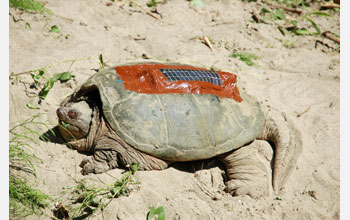Multimedia Gallery
TurtleNet (Image 4)
TurtleNet (Image 4)
A fully equipped snapping turtle is ready for release. The turtles are being studied as part of TurtleNet, an experiment along the Deerfield River in western Massachusetts that is seeking to help some turtle species in the area, including snapping turtles and the wood turtle, that may be headed for decline as land development shrinks their habitat. Biologist Mike Jones tracks the snapping turtles while computer engineer Matt Garber tests a new wireless communication network. The idea behind the technology is to create a network of constantly moving devices that record and store information, transmit data from one device to another, and then relay all the saved information to a central location while running on self-charging batteries.
A solar-powered computer taped to the back of snapping turtles--light enough so it doesn't weigh the turtle down or interrupt their mating habits--takes periodic readings of the reptiles' location and body temperature. When one computer-carrying snapper gets within a tenth of a mile of another, the machines swap information. The series of short-distance transmissions allows for long battery life in each computer, and the solar panels attached to the units are expected to constantly keep the batteries charged. Without a relay system, a longer transmission would require a larger battery that would drain too quickly or be too big for a turtle to carry. The turtle-to-turtle relay ends when one of the snappers passes near a single base station that receives all the accumulated information. While Jones thinks the snappers may roam up to 10 miles from the Deerfield swamp they know as home, he says it's in their nature to return to the bog where the base station is.
The TurtleNet project was funded by grants from the National Science Foundation (CNS 05-19881, CNS 05-20729 and CNS 04-47877). To learn more about TurtleNet, visit the project Web site at http://prisms.cs.umass.edu/dome/index.php?page=turtlenet.
This image is copyright and was included in the NSF Multimedia Gallery with permission from the owner. See "Restrictions" below regarding use of this image. (Date of Image: 2007) [Image 4 of 4 related images. Back to Image 1.]
Credit: ©University of Massachusetts Amherst Computer Science Department; photo by Mark Corner (UMass Amherst, CS Dept.)
Special Restrictions: Copyright image. Permission to use for personal, educational and nonprofit/non-commercial use only.
Images and other media in the National Science Foundation Multimedia Gallery are available for use in print and electronic material by NSF employees, members of the media, university staff, teachers and the general public. All media in the gallery are intended for personal, educational and nonprofit/non-commercial use only.
Images credited to the National Science Foundation, a federal agency, are in the public domain. The images were created by employees of the United States Government as part of their official duties or prepared by contractors as "works for hire" for NSF. You may freely use NSF-credited images and, at your discretion, credit NSF with a "Courtesy: National Science Foundation" notation.
Additional information about general usage can be found in Conditions.
Also Available:
Download the high-resolution JPG version of the image. (2.8 MB)
Use your mouse to right-click (Mac users may need to Ctrl-click) the link above and choose the option that will save the file or target to your computer.



